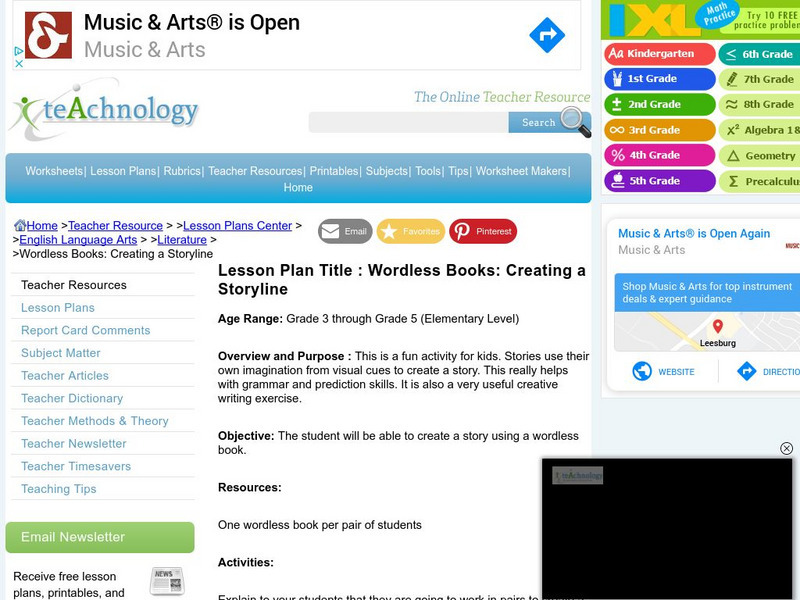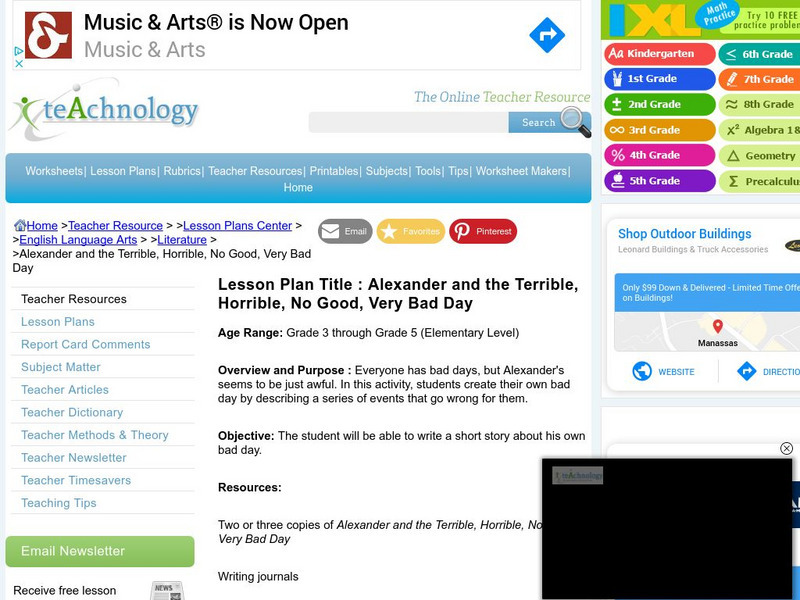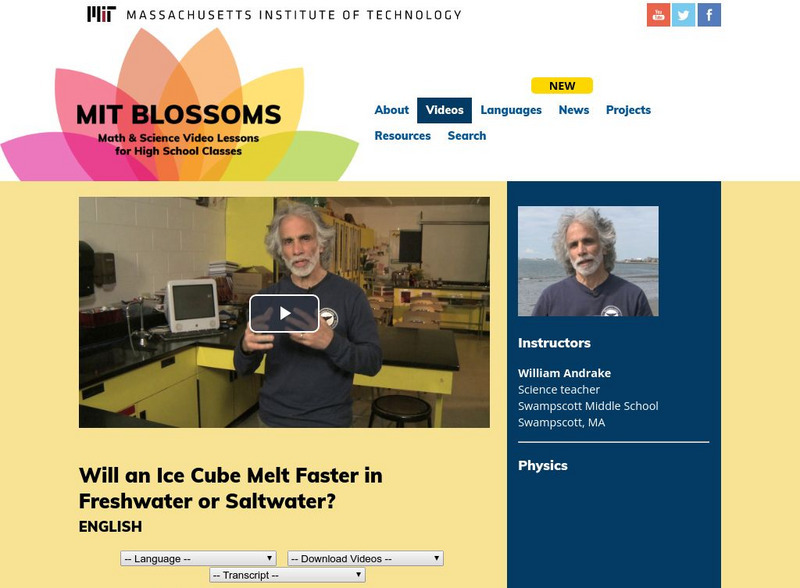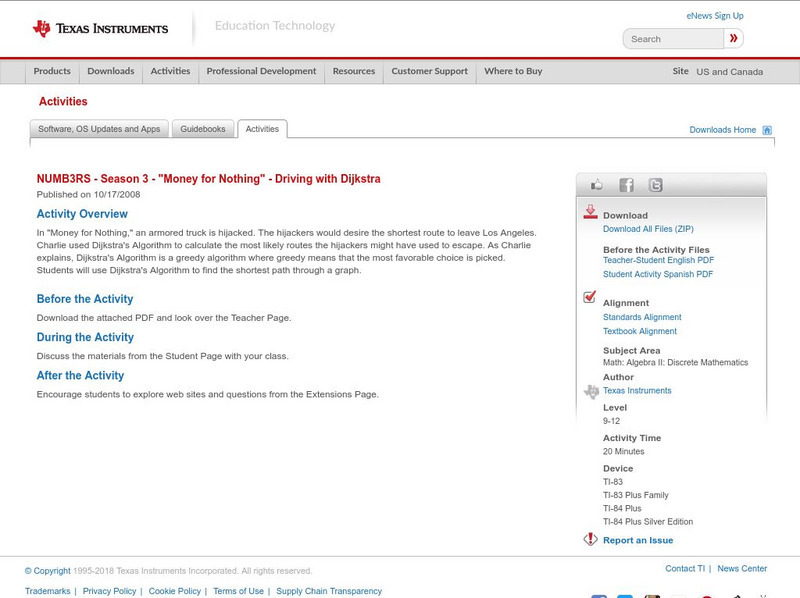Hi, what do you want to do?
Curated OER
Literature - Overview - May
Third graders study sayings and phrases, poetry and stories in this month's activities.
Curated OER
I'm 93, But Quitting Job Would Drive Me Off My Trolley
Students read and discuss a news article about the elderly in the workplace. They use the content of the article for practice in making predictions, determining verb tense, and basic comprehension.
Curated OER
Where in the World Clues
Students demonstrate ability to access information and classify that information as broad or specific. They create a game to share with other students.
Curated OER
Buildings Tell A Story
Fourth graders identify basic architectural features of buildings in their community and identify the changes in local buildings. They draw a sketch of a local building from memory. They compare and display student sketches.
Curated OER
Train Cinquain
Fourth graders write cinquain poems showing an understanding that people cannot outrun trains. They examine safety messages concerning tunnels, bridges and trains.
Curated OER
Studying Living Organisms
Students discover and discuss the differences between prokaryotes and eukaryotes. Using a microscope, they examine various prepared slides of prokaryotic and eukaryotic organisms.
Curated OER
Breaking News English: Hillary Clinton Collapses
In this English worksheet, students read "Hillary Clinton Collapses," and then respond to 10 multiple choice, 47 fill in the blank, 7 short answer, 20 matching, and 8 true or false questions about the selection.
Curated OER
Breaking News English: Woman Gives Birth at 66
In this English learning exercise, students read "Woman Gives Birth at 66," and then respond to 47 fill in the blank, 7 short answer, 20 matching, and 8 true or false questions about the selection.
ReadWriteThink
Read Write Think: Using Read Aloud as a Springboard to Writing
Using "Thunder Rose" by Jerdine Nolen, this lesson plan explores elements of tall tales. Included in the lesson plan is an overview, practice, objectives, resources, preparation, and more.
Teachnology
Teachnology: Lesson Plan: Wordless Books: Creating a Storyline
This lesson plan asks students grades 3-5 to use wordless picture books as a springboard to write an original story based on the pictures.
ReadWriteThink
Read Write Think: Childhood Remembrances: Lesson Plans for "Nikki Rosa"
Using Giovanni's poem as a springboard, these lessons guide students through an autobiographical writing exercise. Includes multimedia and interactive elements.
Teachnology
Teachnology: Lesson: Alexander and the Terrible, Horrible, No Good, Very Bad Day
In this lesson, students use the book Alexander and the Terrible, Horrible, No Good, Very Bad Day as a springboard for writing their own very-bad-day story.
Edutopia
Edutopia: The Kentucky Derby, Springboard to Lessons in American Culture
The Kentucky Derby offers many opportunities for teaching students about American culture and history. Numerous ideas are suggested here for engaging students in this American tradition. (Date of article: 4/30/10)
Writing Fix
Writing Fix: Compare & Contrast as an Idea Springboard
For this Writers Workshop lesson, learners read Frog and Toad stories by Arnold Lobel to learn about writing that compares and contrasts to things. This format can be used to write about many different topics in curricular areas and...
Other
English to Go: "Animal Apps"
An article about the US and Canadian zoos using apps to teach apes is a springboard for this creative activity. Pre-reading questions, the article from Reuters, and follow-up summary in addition to grammar exercises make up a complete...
Massachusetts Institute of Technology
Mit: Blossoms: Will an Ice Cube Melt Faster in Freshwater or Saltwater?
Engage students in the study of the ocean and saltwater with these activities. Students will see that saltwater has different physical properties than freshwater - mainly density. This lesson can serve as a springboard into other...
PBS
Pbs Teachers: Story Writing With Arthur
This series of 12 downloadable activities teach students some basics of story writing, using books or videos from the PBS "Arthur" series as a springboard. Activities include creating story maps, asking questions about characters and...
Texas Instruments
Texas Instruments: Numb3 Rs: Driving With Djikstra
Based off of the hit television show NUMB3RS, this lesson introduces students to one of the prominent algorithms in graph theory used to find shortest paths -- the Djikstra Algorithm. The lesson includes four graphs of increasing...
Peace Corps
Peace Corps: Looking at Ourselves and Others
Adapted lesson plans, used by the Peace Corps to prepare their volunteers, are divided into three suggested grade grouping: 3-5, 6-9, 10-12. These activities introduce students to the concepts of perspective, culture, and cross-cultural...
Texas Education Agency
Texas Gateway: Writing: How to Write a Personal Narrative
A learning module that teaches students how to write a personal narrative with five mini-lessons: Introduction, Consider a Slice of Your Life, FOCUS!, Develop Your Central Idea, and Wrap Up and Springboard to Writing.
Other
Web Worksheet Wizard: Narrative and Descriptive Prompts
Come and check out this list of narrative and descriptive writing prompts. These can be used as springboards for your writing.
Texas Instruments
Texas Instruments: Numb3 Rs: Riding the Waves
Based off of the hit television show NUMB3RS, this lesson introduces students to the idea of vector fields. While no "formal math" is done in this lesson, students will learn to follow a vector field both forward and backward to see...
University of Oregon
Pizzaz, Creative Writing & Storytelling: Creative Writing via Basket Stories
This PIZZAZ (People Interested in Zippy and ZAny Zcribbling) lesson plan will engage young scholars in creative writing about items found in a basket. Examples of creative writing are provided. Examples of springboard ideas are included.
ArtsNow
Arts Now Learning: Exploring Social Studies Through Playwriting [Pdf]
For this lesson, 6th graders use photos of people in real-life events from the Zapatistas Movement as a springboard to write a dialogue between the people in the photograph. Students then work in pairs to create a scene that addresses...



























